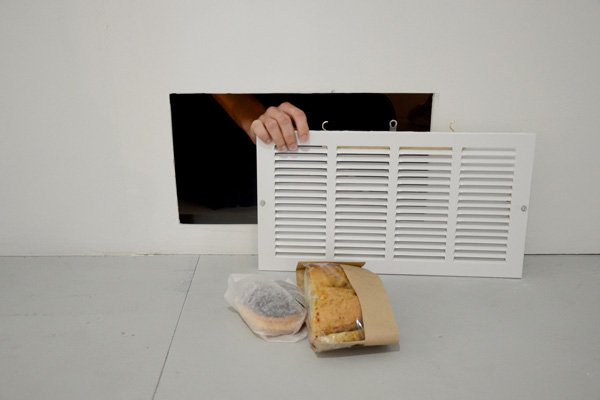What is it like to live inside a crawl space for three weeks? Cuban artist Alejandro Figueredo Díaz-Perera knows, but he isn’t talking; or rather, he has taken a vow of silence during a self-imposed exile behind the wall of a gallery at the Chicago Artists Coalition. A slim corridor behind some drywall measuring 2.5-feet wide and 10-feet long is Díaz-Perera’s home during his solo exhibition at the West Loop gallery (through 2/26). He has only a mat, a pillow, a blanket, a lamp, and a hammer—in case he needs to smash his way out in an emergency. Food is passed through a vent. You can hear him breathing.
“When you enter this space, I am here, but you will not see me. I am behind the walls,” reads the artist’s statement.
Born in Havana during the direst times of Cuba’s economic crisis, amid famine, poverty and overcrowding, the 23-year-old artist emigrated to the U.S. last year to start life anew in Chicago, leaving behind his mother and homeland.
The complicated state of U.S.-Cuban relations prompted Díaz-Perera to stage his version of the invisible man. Despite the co-announcement by President Obama and Raul Castro last December that the two countries will open their borders to each other, civil-rights activists in Cuba are still being censored and detained, such as the internationally regarded Cuban artist Tania Bruguera, who was imprisoned in December for attempting to set up an open microphone for Cubans to speak their minds in public. Díaz-Perera pays homage to his friend Bruguera by displaying a live mic in his own exhibition, rigged with a machine to bang itself repeatedly against a wall. As a Cuban national awaiting his U.S. green card, Díaz-Perera fears for his residency status if he, too, is outspoken.
Díaz-Perera is in limbo. And so, the liminal space behind the wall seemed like the right place to stage his quiet protest. “He calls this an action, not a performance,” says Teresa Silva, the gallery’s director of exhibitions and residencies. “He feels a little bit powerless, but also empowered,” says Silva, who contrasted Cuba’s unfolding historical moment with the fall of the Berlin Wall. “There is celebration, but also frustration and hesitancy,” she says, “as we don’t really know what the normalization of Cuba really means yet for the future.” For instance, in January, Castro demanded the closure of the Guantánamo base in Cuba, but the U.S. is not likely to comply.
To prepare for the endurance performance, Díaz-Perera trained with performance-art master Marina Abramovic, who, in 2010, sat silently with visitors at the Museum of Modern Art for ten weeks straight. Abramovic taught Díaz-Perera how to reduce the needs of his body in order to sustain the weeks-long performance. No internet, no books, and nothing to write with, Díaz-Perera waits quietly for visitors.
Díaz-Perera’s partner, Cara Megan Lewis, brings food, water, and news of the world each day. She has also become his spokesperson.
“It’s not a prison,” says Lewis of the crawl space, “and he’s not in hiding. It’s not about deprivation or suffering or torture,” she says. Instead, the performance is like an introspective quest, summed up by the phrase: “the personal is political.” Visitors are invited to experience the artist’s simultaneous presence and absence in the gallery—a strange feeling, akin to Díaz-Perera’s struggle for freedom of expression, complicated by his immigrant status.
Lewis is not uncomfortable becoming implicated in her partner’s work. In fact, the two artists have performed political art acts together, such as simultaneously bleaching the flags of their home countries during a performance art festival last May. Now, the gallery wall, which divides this American-Cuban couple, dramatizes the nearly impossible interactions for all Americans and Cubans, as communication between the two countries is difficult and expensive. Díaz-Perera’s monthly phone call to his mother can cost $30. Not even Skype is free in Cuba.
On Valentine’s Day, Lewis passed a plate of home-cooked food through the vent for Díaz-Perera. They were one week into the performance, with two more long weeks ahead. “Absence definitely makes the heart grow fonder,” she lamented. Lewis and Díaz-Perera met during the Havana Biennial in 2012. They kept in contact, sending expensive text messages to each other, which resulted in a published book of their correspondence. Then, he emigrated from Cuba last year in order to live with her.
Like all Cuban immigrants to the U.S., Díaz-Perera is on a fast track to permanent residency, thanks to the Cuban Adjustment Act, passed by President Johnson in the sixties to help Cuban political refugees seek asylum. Now, no matter how a Cuban enters, if they live in the U.S. for a year and a day, they are entitled to a green card. More than 22,000 Cubans benefited from the act in 2014 alone, according to the Havana Times, but it can be revoked if, during the year in limbo, the Cuban immigrant breaks the law. With the new “normalization” of U.S.-Cuba relations, there has been talk of eliminating the Cuban Adjustment Act. Díaz-Perera is due to be a naturalized U.S. citizen in July.
"Artists have a call to a purpose,” says Lewis. “How we respond to political situations matters. The artistic response has a ripple effect, but can it effect change?”
Alejandro Figueredo Diaz-Perera’s In the Absence of a Body shows through February 26 at the Chicago Artists Coalition, 217 N Carpenter. chicagoartistscoalition.org.



